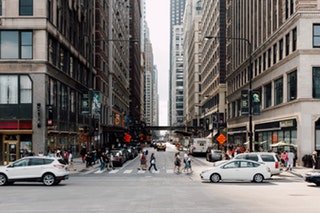Looking at the DAV Network From Top to Bottom (Project Analysis)
What is DAV?
DAV is an open-source blockchain-based transportation platform that will autonomous vehicles to communicate, discover, and transact with each other. The platform will allow vehicles and users to buy and sell their services.
The DAV Foundation is working in tandem with DAV to incentivize the building of autonomous vehicle infrastructure in cities throughout the world.
All of the transactions on the platform will be paid for using the native token of the network, DAV.
Below is a T.E.C.T.U.S. analysis which provides an overview of the technology, economics, competition, team, the utility of the token, and social metrics of the project.
T.E.C.T.U.S. Analysis

The technology behind DAV is not highly technical when compared to projects that building entire blockchains from the ground up. The purpose of DAV is to create a network of cooperation between autonomous vehicles, their users, and their service providers.
DAV networks technology is a stack of open-source software that has a simple, user-friendly UI that allows developers to easily integrate it into various solutions within the autonomous vehicle and transportation ecosystem.
The five components of the tech stack are identity, discovery, communication, mission flow, and payments. Each of these components will be completely decentralized and some will utilize a p2p node protocol that is based on Kademlia8 DHT. This protocol uses the same algorithm as BitTorrent and Ethereums node discovery.
The tech stack will be used to create identities for each entity on the network. Each entity will have a reputation that is recorded in the blockchain. Entities in the ecosystem include vehicles, service providers, and users.
All of the entities must be able to discover each other and communicate autonomously. For example, a drone must be able to locate and use a charging station without the help of a human. This discovery and communication utilize both on and off-chain functions.
The off-chain events include communication between two nodes. This may include a drone and a charging station, or a passenger and a ship. The on-chain communication will include any transfer of DAV tokens or creation or execution of a smart contract.
At the core of DAV technology are smart contracts. The team has well known smart contract auditor Nick Johnson on board as an adviser which should help them in the process of creating safe and effective contracts.

The token economics is based on a system that rewards participants for their work and also as an incentive to develop the physical infrastructure needed for the project to survive. The incentive system is a two-tier system.
These incentives will create a demand for DAV tokens because they will be funded with tokens that the DAV Foundation purchases at market value from exchanges. The receivers of these incentive tokens cannot immediately "dump" their tokens as they will be limited to specific uses via smart contract.

At this time there is no off-chain counterpart to DAV. Segments of the DAV network exists outside but not as a whole. Ridesharing platforms like Uber and Lyft are part of a passenger economy that DAV is attempting to decentralize.
Last mile shipments from couriers and businesses like UPS, FedEx, and Amazon are in a niche that DAV is trying to enter.
An important factor to consider is that these businesses can exist on top and in conjunction with the DAV Network. Uber and Lyft can integrate the DAV Network into their operations. Autonomous cars can be hired, deployed, and paid with no change in how the customer interacts.
The main competition is that as a new infrastructure for autonomous vehicles is built it is possible that a single entity or a small number of entities attempts to privatize the ecosystem. This would force users into an autonomous vehicle silo where they can use only compatible vehicles, charging stations, and parking spots.
Ultimately the competition will be how open 3rd parties are to integrating themselves with a network by sharing resources and data.

The team is large with over 15 members from industries that include big data, machine learning, cryptocurrency, encryption, mobile apps, web apps, AI, self-driving cars, design, and marketing.
The CEO and founder Noam Copel created the world’s first smartphone encryption system that was licensed by the Israeli Minister of Defense and is used in over 50 countries.
The advisor set is full of all-stars including experts from the automotive industry (GM), NASA, Ethereum, SAP, FAA, UPS, Cisco, Ford, and IBM. Each of the advisors appears to be hand selected to aid the project with specific tasks.
There are two main groups that participate in the token economy, consumers and providers. Consumers will use DAV tokens to exchange for the transportation of goods, services, and people.Providers earn tokens in multiple ways that include:
- Providing vehicles for use on the network
- Providing infrastructure that includes charging stations, parking spaces, and repair equipment
- Providing services such as repairs or locating lost or damaged vehicles
- Manufacturing open source autonomous vehicles
- Providing insurance for cargo, vehicles, and people
- Providing dispute resolution involving damaged goods and proof of delivery
- Contribute to the development of the open-source platform through bounties and third-party apps.

The Telegram group has over 13,000 members and has active moderation by Amazix. The Twitter account posts daily news snippets.
The Medium has been regularly updated and provides information about the project as well as the token sale.
The project did have early hype, especially linked to the advisory group. When ICO winter took hold the projects social momentum lost some steam. There has been no FUD that I've seen other than many comments about a long time horizon for the project to really get going.
The Vitals
If you would like to use the DAV Network as a buyer or seller then you can purchase tokens on an exchange when available or via the token sale.
📅ICO Date: June 11, 2018.
📈Token Ticker: DAV
💵Token Price: 10,000 DAV/ETH
Total Supply at TGE: 1,771,428,571 DAV
Hardcap: $38 million
Amount for Sale: 40%
Token Type: ERC20
DAV Website ||Whitepaper ||Telegram || Bounty
Keep up with me:
Twitter || Telegram Group || BitcoinTalk Profile

*This post contains a project overview not investment advice. As always do your own research before participating in a project of any fashion.
*All photos courtesy of pexels.com



